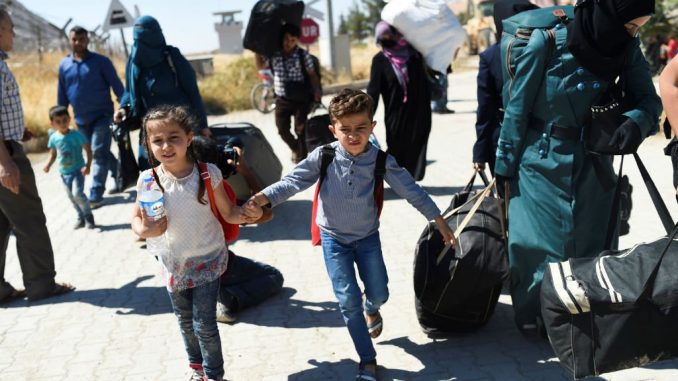
Tens of thousands of displaced Syrians have returned to an area controlled by Turkey and Turkish-backed opposition fighters in northern Syria, Turkey’s foreign minister said Saturday.
Turkey’s military operation in Syria named Euphrates Shield, which was launched last August to drive Islamic State militants from its border and prevent Kurdish fighters from gaining ground and strengthening their positions, has changed the balance of power in northern Syria and added more tension to the already complicated area.
Under Euphrates Shield, Turkey took the border town of Jarablus on the Euphrates river, cleared ISIL fighters from a roughly 100-km (60-mile) stretch of the border, then moved south to al-Bab, an ISIS stronghold where Yildirim said “everything is under control”.
Turkey’s operations against ISIS aimed at ending the group’s existence near its borders and the group’s ability to pose threat to its internal peace, in addition to eliminating the YPG Kurdish militias who control large areas near Turkish border.
After al-Bab, Turkey said its next aim is to retrieve Manbij city from the Kurdish militias and move forward to battle ISIS in Raqqa. However. Turkish military declared surprisingly ending the Euphrates Shield operation in Syria as its goals have been achieved.
Civilians returning to their homes
Turkish Foreign Minister Mevlut Cavusoglu’s comments came three days after Prime Minister Binali Yildirim said Turkey’s Operation Euphrates Shield that began in August had ended after its troops and allied rebels secured territory along the border between Turkey and Syria.
Cavusoglu said some 50,000 people have returned from Turkey to areas that have been captured by Turkish troops and Turkey-backed opposition fighters, adding that security in these areas should eventually be handed to local forces.
“People started returning to these places,” Cavusoglu said during a visit to the coastal city of Izmir in western Turkey. “Our soldiers are still there and we need to conduct the work there. We need to establish a terror-free zone.”
“The necessary work needs to be done for security to be handed over to local forces. We are continuing our work, including train and equip,” he added.
Evacuation towards northern Syria
In the past two weeks, hundreds of rebels and their families were evacuated from Homs city to Jarablus on the border with Turkey under a deal with Assad regime.
On March 12, the negotiators from al-Waer besieged area had signed the agreement for rebel factions and their families to surrender and leave Homs city.
The deal follows other agreements that were never fully implemented between the government and rebel groups in al-Waer, their last bastion in Homs, which has been pounded by air strikes in recent weeks.
Both sides signed the deal according to which opposition fighters and their families who choose not to accept living under Assad regime’s control, will be forcibly displaced and head to Idlib, or Jarablus in northern Syria.
The agreement underlines Assad regime’s upper hand in the war, as more rebel fighters were forced to leave areas they have defended for years in deals that amount to negotiated withdrawals to other parts of the country.
The first stage of displacement was conducted on March 18. and included evacuation 1100 civilians and more than 400 rebel fighters.
The Second stage of the evacuation of the last opposition-held neighborhood in the central city of Homs was resumed on March 27.
At least 667 rebels, along with their families, for a total of 1850 residents, were taken by bus in the direction of the rebel-held city of Jarablus, near the Turkish border, according to an official in the Homs Governorate administration.
The Syrian Observatory for Human Rights, a Britain-based war monitor, said the buses would go to the Jarablus area held by Turkey-backed rebels in the northern Aleppo countryside.
Once completed, it would mark the biggest evacuation during the war out of one Syrian district, which is home to about 40,000 civilians and more than 2,500 fighters, the monitoring group said.
“It’s because there is zero trust in Assad’s government. That’s why the numbers are high,” said the head of the Homs Media Center, run by opposition activists. “For years, it has besieged us…and bombed people’s homes.”
Assad regime describes the evacuation deals as “reconciliation” or “settlement agreements”, but rebels say they involve the forcible displacement of whole communities from opposition areas after years of siege and bombardment.
The Syrian crisis began as a peaceful demonstration against the injustice in Syria. Assad regime used to fire power and violence against the civilians and led to armed resistance. 450.000 Syrians lost their lives in the past five years according to UN estimates, and more than 12 million have lost their homes.



